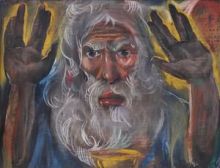Glory often finds artists after their death, and this course of events even used to be considered natural. Now artists do not have to wait too long for recognition, and the latter often comes to the dwelling place of not so young masters. What is this glory about? Titles and prizes? Public acknowledgement? The so-called non-human-made monuments? You will, naturally, admire such people if you enumerate their titles and achievements. But you need to “dig deeper” and try to peek into the artist’s soul to see that entirely different things make him or her happy.
Yevhen Beznisko, Shevchenko Prize winner (2006), Merited Painter of Ukraine (1989), knows the price of happiness. The artist turned 75 on October 19!
On October 19, Beznisko displayed about 300 works associated with the oeuvres of Taras Shevchenko at the Lviv Picture Gallery. Yet the artist mostly devoted his lifetime to illustrating Ivan Franko’s works. To be frank, it is difficult and even wrong to call them illustrations because the inimitable nature of canvases allows one to interpret them loosely and encourages the spectator to think in historical and philosophical terms. The personality of this acclaimed writer runs all through the creative life of the artist. He has been captivated with Ivan Franko’s literary heritage since he was a youth and is still drawing bright and unforgettable images on paper.
The Khmelnytsky Oblast Art Museum is now hosting an exhibit of the artist’s two cycles of work, including his peak oeuvre Moses. Incidentally, one can see illustrations to Ivan Franko’s works not only in Khmelnytsky – the artist has donated about a half of his Franko-related works to Lviv National Ivan Franko University.
“I think I owe my association with Franko to the fact that Nahuievychi [his birthplace. – Ed.] was very close to Sambir, where we lived. We visited that place in 1948 or 1949: there was no museum yet – just the house where Ivan Franko was born. Like all the others, I ‘did’ the writer’s all works in school, but the classic did not exactly stir a ripple… But when I was in Lviv, Ihor Sandursky gave me Franko’s prologue to Moses to read. Then, in the early 1960s, I began to meet the local intelligentsia. Ivanchuk was by far the only Lviv resident who knew Moses by heart. This stung me a little. So I also learned the poem by heart,” Beznisko confesses.
Incidentally, it is Moses with which the artist began to reconsider the classic’s oeuvres.
The time span between the cycles displayed at the Khmelnytsky Oblast Art Museum is almost 40 years. Beznisko began to work on his first pictures in the 1960s. Incidentally, Beznisko’s first illustrations to Franko’s works became a landmark in culture. This cycle of drawings was the reason why the author was put on a security risk list.
“From 1963 to 1969 I worked on a series of Franko-related graphic designs. I would often get back to him,” the artist goes on, “and now I am doing this again. I’ve made 56 illustrations since then, and I was once awarded the Shevchenko Prize for them. But the book with these illustrations no longer exists.
“There was an Englishwoman, Vera Rich, who learned the Ukrainian language at 21. She translated Shevchenko, Franko, Lesia Ukrainka, and Stefanyk. Moses was also among the works she translated. We first wanted to publish the prologue to Moses, with my illustrations, in all the languages it had been translated into. It was in 1969. But, thanks to some ‘friends,’ our plans came unstuck. 40 years have passed now. The Drohobych-based Kolo Publishing House intended to make an English-Ukrainian book with my 56 illustrations. Vera Rich died two years ago – she never saw the publication of her translations. Incidentally, she willed to bury her in Kaniv, closer to Shevchenko, and her body reposes now on the Kozacha Hill, next to the Chernecha Hill. I must be a long-liver, for I’ve had to wait throughout my lifetime. And it is 40 years that I’ve been waiting for Moses to be published.”
The creation of the second cycle was preceded by a trip to Egypt in 2005, where the artist had an opportunity to follow the way of Moses, fully feel the Sinai’s mystical atmosphere, and reconsider that oeuvre of Franko’s, so close to him. Unlike the previous series, this one is not black and white – it is done in a pastel drawing style. The artist was astonished in Egypt that Franko managed to express so convincingly the landscape and spirit of these lands without having ever been there.







